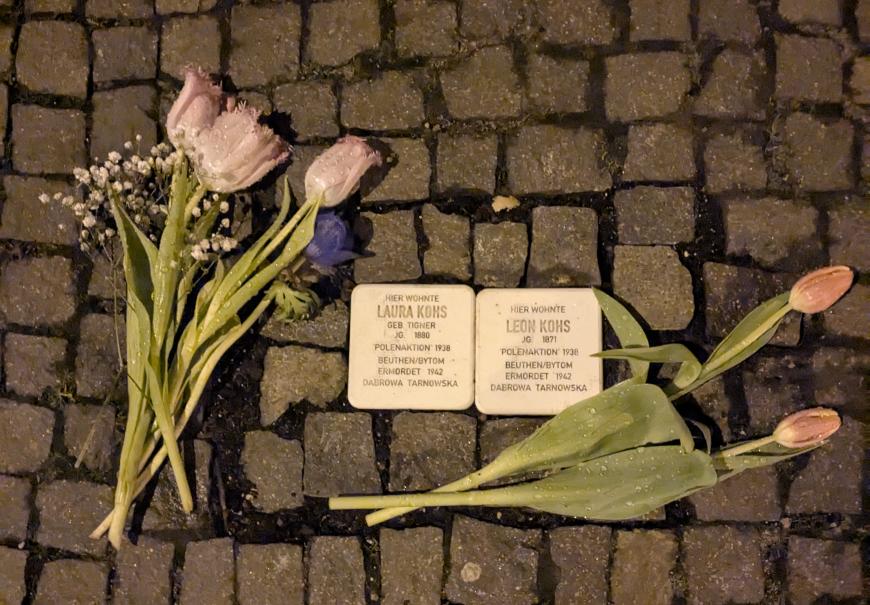published: 12 March 2025
“Remembrance is always discussion”
Susanne Siegert is a German memory activist. She shares content about history and memorial culture on Instagram and Tiktok. For example, she has been restoring stolen from the streets, much like Russian activists who restore the Last Address plaques on city walls. We talked to Susanne about her involvement in memory culture.
About five years ago I started doing research on a former Dachau subcamp called the Mühldorf subcamp in my hometown near Munich, where I went to school and where my parents still live. I began researching it in online archives purely out of personal interest. We never really talked about it in school—it’s not very well-known in the region. But I found a lot of information online, particularly in the Arolsen Archives and other collections. I wanted to share what I was discovering.
Since I have a Bachelor and Masters degrees in journalism and would describe myself as a media-savvy person—I also use social media a lot privately and work professionally in marketing—I decided to start sharing what I found on social media, first just Instagram, then Instagram and TikTok. At first, it was really just a way for me to stay motivated to keep researching. And honestly, that’s still my biggest motivation: I want to keep learning new things. It’s something I continue to do every single day.
At the beginning of the year, I was walking through my neighborhood and noticed that some Stolpersteine (stumbling stones) were missing from one spot. I looked into it and found out that they had been removed/stolen back on December 20th! By then, about two weeks had passed. I thought it was so striking that for two weeks, there was just this empty hole in the ground, and the place where these two persecuted individuals had lived was no longer marked as such. My first thought was simply to mark the spot somehow, maybe with a sign, and say, “Hey, look, something is missing here.”
What really surprised me was that someone who saw my video about it on TikTok reached out to me and said, “Hey, I have a 3D printer at home. I can create a replacement Stolperstein with it and send it to you.” I received the 3D-printed Stolperstein, and was able to lay it down at that spot. I thought this was a really great example of how you can combine traditional, hands-on forms of remembrance with new technologies. Personally, I’m not always a fan of using things like AI, virtual reality, augmented reality, or holograms for remembrance. But I do believe that smaller, more accessible technologies, like social media, can make a big difference. I’ve noticed that people are definitely interested in these topics, but they want to engage with them at a different pace and in a different format than what’s typically offered in schools, memorial sites, exhibitions, or museums.

There are some criticisms in Germany regarding the stumbling stones. One common argument is that people feel like they’re “walking all over the victims” again, literally trampling on them. I can absolutely understand this criticism, and I think it’s important to listen to these concerns. But I also believe that remembrance is always about negotiation and discussion. There will always be forms of commemoration that some people prefer over others. There are both survivors and others—let’s say, non-affected individuals—who really appreciate Stolpersteine, but there are also survivors who don’t like them at all. I think that’s something remembrance culture needs to tolerate and grapple with. Personally, I really like this form of commemoration because it integrates memory into everyday life. For example, just realizing, “Wow, on this street alone, there were ten houses where Jewish victims lived, and today there’s almost no visible trace of Jewish life left.” That kind of moment is so significant.
It’s crucial to make people understand that this isn’t ancient history. Sure, it’s been 80 years now, but it still has an impact on our lives today. German Basic Law is the way it is because of that time. Our cities look the way they do because of that time. And even the relationships we, as descendants of perpetrators, have with our own family members are shaped by that period.
I think that remembering the Holocaust is, of course, especially important in Germany. However, I don’t think we should expect that simply knowing enough about this history will stop people from voting for far-right parties. I believe that shouldn’t be our primary aim. Holocaust remembrance has value in and of itself; it has a reason to exist without necessarily having to serve as a lesson that makes us all good democrats. Although it’s still important to point out parallels to the present, I think this needs to be done in a more fact-based way.
